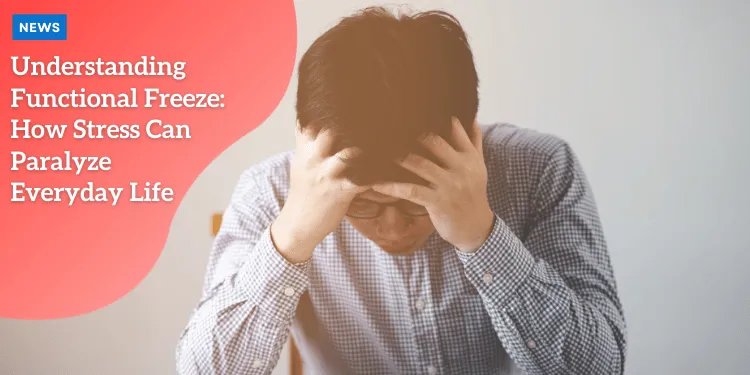Understanding Functional Freeze: How Stress Can Paralyze Everyday Life

Introduction
In the face of various stressors, our bodies can react in unexpected ways, one of which is by entering a state of “freeze”—a physical, mental, and emotional shutdown.
Anúncios
While this response may be adaptive in life-threatening situations, such as facing imminent danger, it becomes perplexing and debilitating in everyday scenarios like attending work or social gatherings.
Many individuals find themselves metaphorically under the covers, unable to move or engage with daily tasks due to overwhelming feelings of paralysis.
This phenomenon is termed as “functional freeze,” a concept not clinically defined but recognized in therapeutic circles under various names like freeze response, autopilot mode, or stress paralysis.
Anúncios
Often, functional freeze overlaps with common mental health issues like depression or anxiety, manifesting as a profound inability to act or engage with the world.
The freeze response, though it’s a normal reaction to certain types of stress, when triggered repeatedly or in non-threatening situations, can be mentally, emotionally, and physically incapacitating.
Understanding the mechanisms behind this response, the signs and symptoms, and strategies to overcome it can be pivotal in restoring mental balance and functioning.
Anúncios
Understanding Functional Freeze
Functional freeze is a state where individuals experience a profound inertia, rendering them unable to initiate tasks or participate in activities that they would typically find manageable.
It can feel like being trapped in an endless loop of exhaustion and overwhelming feelings, preventing any sort of productive engagement with the world.
Unlike the fight-or-flight response, where the body prepares to confront or flee from a threat, the freeze response involves a state of immobilization, akin to being stuck in a mental and emotional rut.
The freeze response is often an involuntary and automatic reaction to overwhelming stress.
This state can lead to significant impairment in daily functioning and quality of life.
Activities that once felt routine, such as going to work, completing household chores, or meeting friends, become unmanageable.
The simplest tasks can feel insurmountable, and individuals may struggle to gather the energy or motivation to get out of bed, attend to their obligations, or engage socially.
For many, this can feel like an intense and deeply uncomfortable state of isolation.
While the body and mind might appear to be at rest, the internal struggle is real.
This shutdown is often not voluntary but rather an automatic response to perceived stress, where the body “checks out” in an attempt to protect itself from further overwhelm.
Unfortunately, this reaction, while it might have served a survival purpose in extreme situations, becomes maladaptive when applied in more mundane or even positive life situations.
Causes of Functional Freeze
The onset of functional freeze can be attributed to the accumulation of stressors over time, much like blocks stacking up in a game of Tetris.
Each stressor, whether it’s work-related pressure, interpersonal conflicts, financial worries, or health concerns, contributes to a mounting sense of overwhelm.
These stressors often act as triggers that activate the body’s innate defense mechanisms, including the freeze response.
The body does not distinguish between survival-level stress and more manageable, daily stress; both can push a person toward the same state of freeze.
There is also a biochemical component involved, where chronic exposure to stress hormones such as cortisol can impair the body’s ability to regulate emotions and mental function.
Prolonged high levels of cortisol can disrupt neurotransmitter activity and create a feedback loop of emotional numbness, heightened anxiety, and mental fatigue.
Eventually, the cumulative burden reaches a tipping point, triggering a state of psychological and emotional shutdown.
This can manifest as an overwhelming desire to withdraw from social interactions, neglect personal responsibilities, and retreat into a state of emotional numbness and physical inertia.
Individuals may become disengaged from life and the people around them, retreating into themselves as a coping mechanism against an overwhelming flood of stress.
In addition, trauma, whether from childhood or more recent experiences, can contribute to the freeze response.
Traumatic experiences, particularly those that were unresolved or never properly processed, can create a hyper-sensitive state where the body remains “on alert,” easily triggering the freeze response even in situations that would not seem threatening to others.
Signs and Symptoms
Recognizing the signs of functional freeze is crucial for early intervention and management.
Symptoms can vary from person to person but tend to share a common theme of profound emotional and psychological inertia.
Some of the most prevalent symptoms include persistent low mood, heightened anxiety levels, social withdrawal, difficulty in self-care routines, and chronic fatigue.
Individuals may find themselves trapped in rigid routines, avoiding deviations that require spontaneity or creativity.
The idea of change or tackling new tasks may feel overwhelming, and the fear of failure or making mistakes amplifies the sense of paralysis.
The mind becomes clouded by self-doubt and fear, further contributing to the inability to act.
Procrastination becomes a pattern, as the mere thought of starting a task leads to a deepened sense of exhaustion.
There can also be physical signs, such as tense muscles, shallow breathing, and a feeling of being physically drained even after rest.
These physical manifestations can act as a constant reminder of the psychological load being carried.
Difficulty in concentrating or making decisions, as well as a growing sense of being disconnected from one’s surroundings, may also be prevalent.
For many, the cycle becomes self-reinforcing: the more they fail to act or engage, the more the freeze response becomes ingrained.
Negative self-talk, feelings of shame, and a belief that one is incapable of performing basic functions can exacerbate the problem, making it harder to break free.
Strategies to Overcome Functional Freeze
While functional freeze can feel like an insurmountable barrier, there are numerous strategies that individuals can employ to regain agency over their lives and break the cycle of inaction.
1. Stress Reduction Techniques
To combat functional freeze, incorporating stress reduction techniques into daily routines is paramount.
Techniques such as mindful breathing exercises, regular physical exercise, and stretching routines can help alleviate tension and promote relaxation.
Meditation, yoga, and deep breathing exercises can help calm the body’s stress response, making it easier to shift from a state of freeze to a more engaged state.
Taking frequent breaks throughout the day, even if brief, can provide much-needed mental refreshment and prevent overwhelm.
A few moments of deep breathing or simply stepping away from a stressful task can help reset the nervous system.
2. Embrace Minimalism and Progress
Adopting a minimalist approach by creating an “it’s done” list can provide a sense of accomplishment and reduce the burden of unfinished tasks.
Focusing on completing small, achievable goals gradually restores a sense of control and motivation.
Breaking tasks down into bite-sized pieces can make them feel more manageable.
Rather than focusing on a massive to-do list, aim for small wins. This can provide a sense of momentum that leads to further action.
3. Grounding and Mindfulness Practices
Engaging in grounding activities, such as walking barefoot on grass, practicing yoga, or doing deep breathing exercises, helps reconnect with the present moment and alleviate feelings of detachment.
Activities like knitting, gardening, or hiking can also serve as therapeutic outlets, promoting mindfulness and reducing stress levels.
These practices help individuals reconnect with the world around them, grounding them in the present moment and helping them move past the feelings of being stuck.
4. Introduce Variety and Flexibility
Breaking out of rigid routines by introducing small changes or deviations can disrupt the cycle of functional freeze.
Whether it’s altering daily commutes, trying new hobbies, or introducing variety into meal plans, embracing spontaneity fosters creativity and prevents monotony-induced stagnation.
The mind thrives on novelty, and introducing small surprises into everyday routines can spark a sense of agency.
5. Emotional Awareness and Mental Health Support
Developing emotional awareness by identifying and naming feelings, even uncomfortable ones, enhances self-understanding and facilitates emotional regulation.
Understanding that it is normal to experience these feelings and giving oneself permission to feel them without judgment is an essential step.
Seeking professional mental health support is crucial for individuals struggling to break free from functional freeze.
Therapeutic interventions, such as cognitive-behavioral therapy or counseling, provide tools and strategies tailored to address underlying causes and promote adaptive coping mechanisms.
Conclusion
Functional freeze presents significant challenges to individuals’ well-being and daily functioning, often arising from the cumulative impact of stressors in modern life.
It’s a complex response that can be triggered by chronic stress, trauma, or overwhelming life changes, and understanding it is the first step in overcoming it.
By recognizing its causes, signs, and symptoms, and implementing effective coping strategies, individuals can regain agency over their lives and navigate through periods of psychological immobilization.
Embracing stress reduction techniques, promoting mindfulness practices, and seeking professional guidance are essential steps toward overcoming functional freeze and fostering long-term mental health resilience.
As awareness grows, so does the opportunity for individuals to reclaim their vitality and engagement with life, ensuring a balanced approach to managing stress and maintaining emotional well-being.
By integrating these strategies into daily routines, individuals can mitigate the effects of functional freeze and cultivate a healthier relationship with stress, promoting sustained productivity and emotional stability.
Reclaiming the ability to move, act, and engage with life is within reach.





